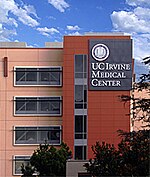
A | B | C | D | E | F | G | H | CH | I | J | K | L | M | N | O | P | Q | R | S | T | U | V | W | X | Y | Z | 0 | 1 | 2 | 3 | 4 | 5 | 6 | 7 | 8 | 9
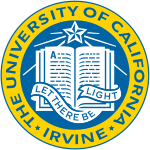 | |
| Motto | Fiat lux (Latin) |
|---|---|
Motto in English | "Let there be light" |
| Type | Public land-grant research university |
| Established | October 4, 1965[1] |
Parent institution | University of California |
| Accreditation | WSCUC |
Academic affiliations | |
| Endowment | $1.3 billion (2022)[2] |
| Chancellor | Howard Gillman[3] |
| Provost | Hal Stern[4] |
Academic staff | 5,596 (2019)[5] |
Administrative staff | 6,426 (2019)[5] |
| Students | 36,505 (2021)[6] |
| Undergraduates | 30,222 (2019)[6] |
| Postgraduates | 5,849 (2019)[6] |
| Location | , , United States 33°38′44″N 117°50′33″W / 33.64556°N 117.84250°W |
| Campus | Large city[8], 1,527 acres (618 ha)[7] |
| Other campuses | Orange |
| Newspaper | New University |
| Colors | Blue and gold[9] |
| Nickname | Anteaters |
Sporting affiliations | |
| Mascot | Peter the Anteater |
| Website | uci.edu |
The University of California, Irvine (UCI or UC Irvine) is a public land-grant research university in Irvine, California. One of the ten campuses of the University of California system, UCI offers 87 undergraduate degrees and 129 graduate and professional degrees, and roughly 30,000 undergraduates and 6,000 graduate students were enrolled at UCI as of Fall 2019.[6] The university is classified among "R1: Doctoral Universities – Very high research activity" and had $523.7 million in research and development expenditures in 2021.[10][11] UCI became a member of the Association of American Universities in 1996.[12]
The university administers the UC Irvine Medical Center, a large teaching hospital in Orange, and its affiliated health sciences system; the University of California, Irvine, Arboretum; and a portion of the University of California Natural Reserve System. UC Irvine set up the first Earth System Science Department in the United States.[13][14] The university was rated as one of the "Public Ivies" in 1985 and 2001 surveys comparing publicly funded universities the authors claimed provide an education comparable to the Ivy League.[15][16]
The UC Irvine Anteaters currently compete in the NCAA Division I as members of the Big West Conference.[a] During the early years of the school's existence, the teams played at the NCAA Division II level. The Anteaters have won 28 national championships in nine different team sports, 64 Anteaters have won individual national championships, and 53 Anteaters have competed in the Olympics, winning a total of 33 Olympic medals.[17] As of January 2022, there have been 5 Nobel Prize laureates,[18] 7 Pulitzer Prize winners, 6 MacArthur "Genius Grant" recipients, 37 Guggenheim Fellows, and 1 Turing Award winner affiliated with the university as alumni, faculty or researchers.[19][20][21]
History
Early years
The University of California, Irvine (with San Diego and Santa Cruz) was one of three new University of California campuses established in the 1960s under the California Master Plan for Higher Education.[22] During the 1950s, the University of California saw the need for the new campuses to handle the expected increase in enrollment from the post-war baby boom. One of the new campuses was to be in the Los Angeles area; the location selected was Irvine Ranch, an area of agricultural land bisecting Orange County from north to south. This site was chosen to accommodate the county's growing population, complement the growth of nearby UCLA and UC Riverside, and allow for the construction of a master planned community in the surrounding area.[23]


On June 20, 1964, U.S. President Lyndon B. Johnson dedicated UC Irvine before a crowd of 15,000 people, and on October 4, 1965, the campus began operations with 1,589 students, 241 staff members, 119 faculty, and 43 teaching assistants.[24][25] However, many of UCI's buildings were still under construction and landscaping was still in progress, with the campus only at 75% completion.[26] By June 25, 1966, UCI held its first Commencement with fourteen students, which conferred ten Bachelor of Arts degrees, three Master of Arts degrees, and one Doctor of Philosophy degree.[27]
Development and recent history
Unlike most other University of California campuses, UCI was not named for the city it was built in; at the time of the university's founding (1965), the current city of Irvine (incorporated in 1971) did not exist. The name "Irvine" is a reference to James Irvine, a landowner who administered the 94,000-acre (38,000 ha) Irvine Ranch. In 1960, The Irvine Company sold 1,000 acres (400 ha) of the Irvine Ranch to the University of California for one dollar, since company policy prohibited the donation of property to a public entity.[23] On campus, UC Irvine's first Chancellor, Daniel G. Aldrich selected a wide variety of Mediterranean-climate flora and fauna, feeling that it served an "aesthetic, environmental, and educational ."[28] To plan the remainder of the ranch, the university hired William Pereira and Associates. Pereira intended for the UC Irvine campus to complement the neighboring community, and it became clear that the original 1,000 acres (400 ha) grant would not suffice. In 1964, the university purchased an additional 510 acres (210 ha) in 1964 for housing and commercial developments.[23]
Much of the land that was not purchased by UCI (which is now occupied by the cities of Irvine, Tustin, and Newport Beach) remains held by The Irvine Company, but the completion of the university rapidly drove the development of Orange County. The City of Irvine became incorporated and established in 1971 and 1975, respectively.[23] UCI remains the second-largest employer in Orange County, with an annual economic impact of $5 billion.[29][30]
Aldrich developed the campus' first academic plan around a College of Arts, Letters, and Science, a Graduate School of Administration, and a School of Engineering. The College of Arts, Letters, and Science was composed of twenty majors in five "Divisions": Biological Sciences, Fine Arts, Humanities, Physical Sciences, and Social Sciences (which transformed into the present-day "Schools").[31] In 1967, the California College of Medicine (originally a school of osteopathy founded in 1896 and the oldest continuously operating medical college in the Southwest) became part of UC Irvine.[32][33] In 1976, plans to establish an on-campus hospital were set aside, with the university instead purchasing the Orange County Medical Center (renamed the UC Irvine Medical Center) around 12 miles from UC Irvine, in the City of Orange.[33]
In early July 2018, UC Irvine removed benefactor Francisco J. Ayala's name from its biology school and central science library after an internal investigation by the university's Office of Equal Opportunity and Diversity substantiated a number of sexual harassment claims. Chancellor Gillman also authorized the removal of the Ayala name from graduate fellowships, scholar programs, and endowed chairs. Ayala resigned July 1, 2018 and was ordered to abstain from future university activities, following the university's consultative procedures that include a faculty review committee. The results from the investigation were compiled in a 97-page report, which included testimony from victims of Ayala.[34][35][36][37][38]
Campus
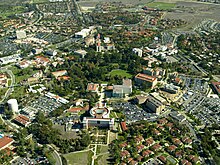
The layout of the core campus resembles a rough circle with its center being Aldrich Park (initially known as Campus Park), lined up by the Ring Mall and buildings surrounding the road. To further emphasize the layout, academic units are positioned relative to the center, wherein undergraduate schools are closer to the center than the graduate schools.[39]
Aldrich Park is planted with over 11,120 trees (there are over 24,000 trees on the entire campus), including 33 species of eucalyptus. Two ceremonial trees were planted in 1990, one for Arbor Day and the second for former chancellor Daniel Aldrich who had died that year. On the first anniversary of the September 11th tragedies, the chancellor planted a bay laurel tree in remembrance of the heroes and victims of the events of September 11, 2001. The tree itself was a gift from the UCI Staff Assembly. Aldrich Park is the site for "Wayzgoose", a medieval student festival held each year in conjunction with the "Celebrate UCI" open house. It also hosts many extracurricular activities.
Ring Mall is the main pedestrian road used by students and faculty to travel around the core campus. The road measures up to a perfect mile and completely encircles Aldrich Park.[40] Most schools and libraries are lined up by this road with each of these schools having their own central plaza which also connects to the Aldrich Park.
Other areas of the university outside of the core campus such as the School of Arts are connected by four pedestrian bridges. Beyond the core campus and the bridges, the layout of the campus is more suburban.
Surroundings
Irvine, California consistently ranks as the safest city in the United States.[41] UCI is close to the beaches, mountains, and attractions of Southern California. Disneyland is approximately 20 minutes away by car. While the university is located in Irvine, the campus is directly bounded by the city of Newport Beach and the community of Newport Coast. The western side of the campus borders the San Diego Creek and the San Joaquin Freshwater Marsh Reserve, through which Campus Drive connects UCI to the 405 freeway. The northern and eastern sides of UCI are adjacent to Irvine proper; the eastern side of the campus is delineated by Bonita Canyon Road, which turns into Culver Drive at its northern terminus. California State Route 73 marks UCI's southern boundary and separates the campus from Newport Beach.
The "North Campus" houses the Facilities Management Department, the Faculty Research Facility, Central Receiving, Fleet Services, the Air Pollution Health Effects Laboratory, and numerous other functions. It is located next to the UCI Arboretum; both the North Campus and the arboretum are located about 1 mile (2 km) from the main campus.
William Pereira's original street layout for the region surrounding the university had a wingnut-shaped loop road as the main thoroughfare, which twice crossed the campus. However, the Irvine Company's development plans expanded before it could be completed, and portions of California, Carlson, Harvard and Turtle Rock roads today constitute segments of what would have been the Loop Road.
Despite the suburban environment, a variety of wildlife inhabits the university's central park, open fields, and wetlands. The university is home to cougar, hawks, golden eagles, great blue herons, squirrels, opossums, peregrine falcons, rabbits, raccoons, owls, skunks, weasels, bats, and coyotes. The UCI Arboretum hosts a collection of plants from California and Mediterranean climates around the world. The rabbits in particular can be seen across campus in high numbers, especially during hours of low student traffic.
Architecture
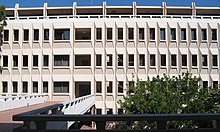
The first buildings were designed by a team of architects led by William Pereira and including A. Quincy Jones and William Blurock. The initial landscaping, including Aldrich Park, was designed by an association of three firms, including that of the noted urban-landscaping innovator Robert Herrick Carter. Aldrich Park was designed under the direction of landscape architect Gene Uematsu, and was modeled after Frederick Law Olmsted's designs for New York City's Central Park. The campus opened in 1965 with the inner circle and park only half-completed. There were only nine buildings and a dirt road connecting the main campus to the housing units. Only three of the six "spokes" that radiate from the central park were built, with only two buildings each. Pereira was retained by the university to maintain a continuity of style among the buildings constructed in the inner ring around the park, the last of which was completed in 1974. These buildings were designed with the appearance of being displayed on "pedestals" (containing the first floor and basement levels) that elevated them above the rolling terrain, with distinctive white railings evoking the deck of an ocean liner. They additionally feature an elevated second pedestrian level above ground, originally intended as a "skyway" to connect all the buildings in each of the six "spokes".[42]

Construction on the campus all but ceased after the Administration building, Aldrich Hall, was completed in 1974, and then resumed in the late 1980s, beginning a massive building boom that still continues today. This second building boom continued the futuristic trend, but emphasized a much more colorful, postmodern approach that somewhat contradicted the earthy, organic designs of the early buildings. Architects such as Frank Gehry, Robert Venturi, Eric Owen Moss, James Stirling and Arthur Erickson were brought in to bring the campus more up to date. The recession in the early 1990s along with internal politics led to a change in direction, due to the reduced capital budget, and changing attitudes towards architectural innovation at the university. This, in turn, led to a "contextualist" approach beginning in the late 1990s combining stylistic elements of the first two phases in an attempt to provide an architectural "middle ground" between the two vastly different styles. Gehry's building was recently removed from campus to make way for a new building, with a design that has been called a "big beige box with bands of bricks". In 2009 the Humanities Gateway building, designed by Curtis W. Fentress, was opened. Its curvilinear design marked a return to the sculptural treatment of concrete begun by Pereira.
As of 2005, the campus has more than 200 buildings and encompasses most of the university's 1,525 acres (6.17 km2).[26] The campus is in the midst of a $1.1 billion construction campaign.[43]
Libraries and study centers

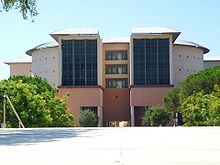
| Jack Langson Library | Resources for the Arts, Humanities, Education, Social Sciences, Social Ecology, and Business & Management disciplines[45] |
| Science Library | One of the largest consolidated science and medical libraries in the nation. Resources for the schools of Biological Sciences, Engineering, Information and Computer Science, Physical Sciences, portions of Social Ecology, and the College of Medicine[46] |
| Grunigen Medical Library | Located at UCI Medical Center, contains 43,000 volumes of material[47] |
| Law Library | Located on the bottom two floors of the Law Building |
In addition to holding a noted critical theory archive and Southeast Asian archive, the Libraries also contain extensive collections in Dance and Performing Arts, Regional History, and more. Additionally, Langson Library hosts an extensive East Asian collection with materials in Chinese, Japanese, and Korean.
Nearly all departments and schools on campus complement the resources of the UC Irvine Libraries by maintaining their own reading rooms and scholarly meeting rooms. They contain small reference collections and are the choice for more intimate lectures, graduate seminars, and study sessions. There is also the large Gateway Study Center located across from Langson Library, one of the university's original buildings and under the custody of UC Irvine Libraries. Having served formerly as a cafeteria and student center, it is now a dual-use computer lab and study area which is open nearly 24 hours.
The UCI Student Center offers a large number of study areas, auditoriums, and two food courts, and therefore is one of the most popular places to study on campus. UC Irvine also has a number of computer labs that serve as study centers. The School of Humanities maintains the Humanities Instructional Resource Center, a drop-in computer lab specializing in language and digital media. Additionally, UCI maintains five other drop-in labs, four instructional computer labs, and a number of reservation-only SmartClassrooms, some of which are open 24 hours. Other popular study areas include Aldrich Park, the Cross-Cultural Center, the Locus (a study room and computer lab used by the Campuswide Honors Program), and plazas located in every school.
Tunnels
A network of tunnels runs between many of the major buildings on campus and the Central Plant, with the major trunk passage located beneath Ring Mall. Smaller tunnels branch off from this main passage to reach individual buildings, carrying electrical and air-conditioning utilities from the Central Plant. These tunnels have been the subject of much campus lore, the most popular story being that the tunnels were constructed to facilitate the safe evacuation of faculty in the event of a student riot. The main tunnel actually contains an above-ground section, in the form of the interior of an unusually thick pedestrian bridge near the Engineering Tower, in an area where the Ring Mall crosses between two hills. The tunnels are only accessible to maintenance staff, although there are also publicly accessible tunnels which intersect the utility tunnels, such as the one that goes between the main Information & Computer Science building and the Engineering Tower.[citation needed]
Washington Center
The University of California, Irvine, created the University of California, Washington Center (UCDC) program in 1982. It is a student program of the university, located on Scott Circle in Downtown Washington ( 38°54′23.4″N 77°2′14″W / 38.906500°N 77.03722°W). The center serves as the headquarters of the University of California Office of Federal Governmental Relations and supports UC students interning in the District of Columbia. UC Washington Center is currently led by UC Santa Cruz economist Helen Shapiro.
Governance
Like other University of California campuses, UC Irvine operates under a system of shared governance, or a partnership between the Chancellor and his administration and the faculty through the Academic Senate. The Chancellor is the chief campus officer and has authority over the campus budget.[48] The Academic Senate has authority to determine the conditions for admission and supervise courses and curricula.[49] The Chancellor is nominated by and is responsible to the Regents of the University of California and the UC President.[50] UCI's Chancellors are listed below:
- 1962 Daniel G. Aldrich
- 1984 Jack W. Peltason
- 1993 Laurel L. Wilkening
- 1998 Ralph J. Cicerone
- 2005 Michael V. Drake
- 2014 Howard Gillman
After the Chancellor, the second most senior official is the Executive Vice Chancellor and Provost,[51] the university's chief academic and operating officer. Every school on campus reports to the Executive Vice Chancellor and Provost through a Dean, and all other academic and administrative units report to his office through a Vice Chancellor or chief administrator. A partial list of these units includes Campus Recreation, Intercollegiate Athletics, Planning and Budget, Student Affairs, UC Irvine Libraries, UC Irvine Medical Center, and University Advancement.
Academics
Academic units

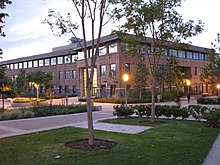


UC Irvine's academic units are referred to as Schools. As of the 2021–2022 school year, there are fourteen Schools, one Program in Public Health, and various interdisciplinary programs.[52] The College of Health Sciences was established in 2004,[53] but no longer exists as a separate academic unit.[54] On November 16, 2006, the University of California Regents approved the establishment of the School of Law.[55] The School of Education was established by the UC Regents in 2012.[56] In 2016, the university announced that it had received a $40 million donation from Bill Gross' philanthropic foundation to turn its nursing science program into the Sue and Bill Gross School of Nursing. The UC Regents formally approved the establishment of the school in January 2017.[57][58] In July 2020, the UC Regents approved the establishment of the School of Pharmacy and Pharmaceutical Sciences.[59] Supplementary education programs offer accelerated or community education in the form of Summer Session and UC Irvine Extension.[60]
The academic units consist of (with their founding in parentheses):[61]
- Claire Trevor School of the Arts (1970)
- School of Biological Sciences (1965)
- Paul Merage School of Business (1965)
- School of Education (1967)
- Henry Samueli School of Engineering (1965)
- School of Humanities (1965)
- Donald Bren School of Information & Computer Sciences (2002)
- Interdisciplinary Studies (1992)
- School of Law (2007)
- School of Physical Sciences (1965)
- School of Social Ecology (1970)
- School of Social Sciences (1965)
- School of Medicine (1896)
- Sue & Bill Gross School of Nursing (2007)
- School of Pharmacy & Pharmaceutical Sciences (2020)
- Program in Public Health (2003)
Health care
The School of Medicine constitute the professional schools of health science. UC Irvine Medical Center is ranked among the nation's top 50 hospitals by U.S. News & World Report for the 12th consecutive year.[62] The School has 19 clinical and 6 basic science departments[63] with 560 full-time and 1,300 volunteer faculty members involved in teaching, patient care and medical and basic science research.
Research organizations
UCI's many research organizations[64] are either chaired by or composed of UCI faculty, frequently draw upon undergraduates and graduates for research assistance, and produce innovations, patents, and scholarly works. Some are housed in a school or department office; others are housed in their own facilities. These are a few of the research organizations at UCI:
- Beckman Laser Institute
- California Institute for Telecommunications and Information Technology (Calit2)
- Center for Chemistry at the Space-Time Limit (CaSTL Center)
- Center for Complex Biological Systems
- Center for Global Peace and Conflict Studies
- Center for Cognitive Neuroscience
- Regional Center of Excellence for Biodefense and Emerging Infectious Disease (RCE)[65]
- Center for Unconventional Security Affairs
- Chao Family Comprehensive Cancer Center
- Institute of Transportation Studies
- National Fuel Cell Research Center
- The Fleischman Lab
- Reeve-Irvine Research Center
- Center for the Study of Democracy
- Center for Health Policy Research
- W. M. Keck Center for Accelerator Mass Spectrometry
- Sue and Bill Gross Stem Cell Research Center
- Institute for Genomics and Bioinformatics (IGB)
- Center for Machine Learning and Data Mining (CML)
- University of California Transportation Center (UCTC)[66]
Rankings
|
|
| ||||||||||||||||||||||||||||||||||||||||||||||||||||||||||||||||||||||||||||||||||||||||||||||||||||||||||||||||||||||||||||||||||||||||||||
Global
Among universities under 50 years of age Times Higher Education ranked UCI 4th in the world and 1st in the US for 2012, 5th in the world and 1st in the US for 2013, 7th in the world and 1st in the US in 2014, and 7th in the world and 1st in the US in 2015.[77] 2015 was the final year UCI was eligible for this ranking. UCI's graduate philosophy program ranks among the finest worldwide, according to the Philosophical Gourmet Report, with the Department of Philosophy and the Department of Logic and Philosophy of Science jointly achieving an impressive 28th position in global rankings.
National
For 2024, U.S. News & World Report ranked UC Irvine tied for 33rd among national universities in the U.S., tied for 10th among public universities, tied for 12th in "Top Performers on Social Mobility", tied for 58th in "Most Innovative Schools", and tied for 62nd in "Best Undergraduate Teaching".[78]
In 2019, Forbes ranked UCI 3rd out of the 300 Best Value Colleges, based on Return on Investment.[79]
In 2017 Kiplinger ranked UCI 26th out of the top 100 best-value public colleges and universities in the nation, and 5th in California.[80]
In 2018, Sierra Magazine ranked UCI 1st in its "Coolest Schools" in America list for campus sustainability and climate change efforts.[81]
In addition, many of UCI's graduate programs are ranked in the top 50 of the 2020 U.S. News & World Report rankings: literary criticism and theory (1), criminology (3), organic chemistry (10), English (17), chemistry (20), sociology (23), computer science (30), physics (28), psychology (36), law (21), education (24), biological sciences (33), earth sciences (41), history (34), engineering (35), business part-time MBA (32), political science (45), mathematics (39), medicine-research (46), and economics (47).[78] According to the Philosophical Gourmet Report, UCI's Department of Philosophy, along with its sister department, the Department of Logic and Philosophy of Science, ranks 24 in the nation.
Learned societies affiliations
UCI faculty are affiliated with the following learned societies.
- American Academy of Arts and Sciences (32 members)[82]
- American Association for the Advancement of Science (115 members)
- American Philosophical Society (11 members)[83]
- American Physical Society (30 members)
- Howard Hughes Medical Institute (1 members)[84]
- American Psychological Association (20 members)
- National Academy of Medicine (5 members)
- National Academy of Engineering (11 members)[85]
- National Academy of Sciences (32 members)[86]
- National Academy of Education (4 members)[87]
Admissions
UC Irvine is categorized by U.S. News & World Report as "most selective" for college admissions in the United States.[88] It was the third-most selective University of California campus for the freshman class entering in the fall of 2019, as measured by the ratio of admitted students to applicants (behind UC Berkeley and UCLA).[89] UC Irvine received 119,210 applications for admission to the fall 2022 incoming freshman class and 25,213 were admitted, making UC Irvine's acceptance rate 21% for fall 2022. The first-year median weighted GPA was 4.22 for fall 2022.[90][91] The incoming 2018 freshmen were predominantly from Los Angeles County, followed by Orange County, the Bay Area counties, San Bernardino County, Riverside County, and San Diego County.[92]
The most popular major for freshmen is a major in the School of Biological Sciences (22%), followed by Undecided/Undeclared (20.6%), Social Sciences (17.4%), Engineering (11.7%), Humanities (8.8%), Physical Sciences (6.1%), Arts (5%), Social Ecology (5%), Information and Computer Sciences (3%), and Health Sciences (0.2%).[93] The average freshman's incoming high school GPA was 3.95. The average SAT scores were 602 (Critical Reasoning), 640 (Mathematics), and 612 (Writing), while the ACT composite score was 26.[94] SAT verbal scores for the middle 50% were 550 and 660, while SAT math scores ranged between 580 and 700.[93]
The choice to offer admission is based on the University of California's comprehensive review program, which considers a candidate's personal situation, community involvement, extracurricular activities, and academic potential in addition to the traditional high school academic record, personal statement, and entrance examination scores.[95] While residency is not a factor in admission, it is a factor in tuition expenses, with out-of-state residents fees much greater than California residents. Since the approval of Proposition 209 in November 1996, California state law has prohibited all public universities (including UC Irvine) from practicing affirmative action as part of their admissions processes.


